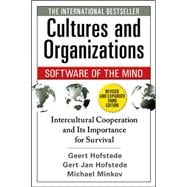The revolutionary study of how the place where we grew up shapes the way we think, feel, and act-- with new dimensions and perspectives
Based on research conducted in more than seventy countries over a forty-year span, Cultures and Organizations examines what drives people apart—when cooperation is so clearly in everyone’s interest. With major new contributions from Michael Minkov’s analysis of data from the World Values Survey, as well as an account of the evolution of cultures by Gert Jan Hofstede, this revised and expanded edition:
-Reveals the “moral circles” from which national societies are built and the unexamined rules by which people think, feel, and act
-Explores how national cultures differ in the areas of inequality, assertiveness versus modesty, and tolerance for ambiguity
-Explains how organizational cultures differ from national cultures—and how they can be managed
-Analyzes stereotyping, differences in language, cultural roots of the 2008 economic crisis, and other intercultural dynamics








